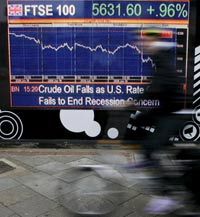After World War I, Victorian-era prudishness began to melt away as adventurous girls dared to display more calf below their skirts. Flappers bedecked in headbands and short, shapeless dresses characterized the decadence of the Roaring '20s. But women's style shifted following the stock market crash in 1929, and during the Great Depression, hemlines dropped back down toward the floor.
In 1926, economist George Taylor noticed that fluctuating fashion. Like the stock market, the length of many women's dresses also fell with a peculiar synchronicity. Perhaps this hemline index, as Taylor coined it, reflected the grim economy's psychological effect on the public. It wasn't a time for rash celebration and risk taking; instead, the Great Depression called for a return to fiscal modesty.
Advertisement
For a while, Taylor's hemline index appeared to have the staying power of the little black dress. When the micro miniskirt fad of the 1960s rolled around, the market was up. Then, with the Arab oil embargo in 1973, long maxiskirts came into vogue as stock values slumped. In the 1980s, perhaps due to the hemline index's sexist overtones, men's neckties became the armchair economic harbinger of choice. Skinny ties foretold a bullish market, and wider ones signified the declining bear [source: Andrew].
Of course, investors don't flip through the latest Bloomingdale's catalogues to decide when to buy and sell. Instead, the hemline and tie indexes are just a couple of far-fetched indicators that enterprising economists have concocted over the years. The amount of snowfall on Christmas day in Boston, images of bears and bulls on major magazines, and Super Bowl outcomes have all been proposed as economic omens. (And finance professionals trust them to forecast market performance about as much as a deck of Tarot cards.)
That isn't to say consumer behavior doesn't have a legitimate relationship with the economy. Consumer spending fuels the economy more than any other single component, comprising more than half of the nation's gross domestic product [source: Investopedia]. But ultimately, the decision to spend or save depends largely on consumer confidence in market security.
Advertisement


